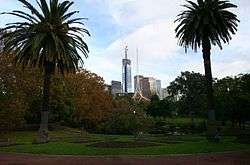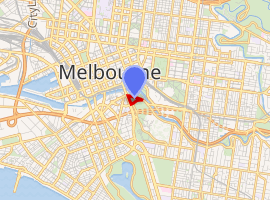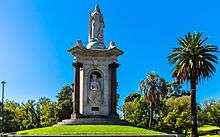Queen Victoria Gardens
The Queen Victoria Gardens are Melbourne's memorial to Queen Victoria. Located on 4.8 hectares (12 acres) opposite the Victorian Arts Centre and National Gallery of Victoria, bounded by St Kilda Road, Alexandra Avenue and Linlithgow Avenue.
| Queen Victoria Gardens | |
|---|---|
 The view from the Queen Victoria statue towards the Victorian Arts Centre | |

| |
| Type | Public Park |
| Location | Melbourne, Australia |
| Coordinates | 37.8218°S 144.9716°E |
| Opened | 1905 |
| Status | Open |
| Paths | Sealed |
| Terrain | Flat, Riverbank |
| Water | Ponds |
| Vegetation | Australian Native, Lawns, Non-native traditional gardens |
| Connecting transport | Tram, Bus, Car |
| Landmarks | Floral Clock |
| Facilities | Toilets, Seating |
Queen Victoria's reign started in 1837, two years after the initial European settlement of Melbourne, and upon her death in 1901 it was thought appropriate to declare an enduring monument to her reign. A memorial statue was commissioned from sculptor James White showing the Queen in ceremonial gowns casting her regal gaze across ornamental lakes, sweeping lawns and rose gardens to the Melbourne Arts Centre Spire and the city skyscrapers.
Queen Victoria Gardens are part of a larger group of parklands directly south-east of the city, between St. Kilda Road and the Yarra River known as the Domain Parklands, which includes;
- The Royal Botanic Gardens
- Kings Domain
- Alexandra Gardens
- Queen Victoria Gardens
Features
A huge floral clock is positioned opposite the National Gallery of Victoria, containing over 7,000 flowering plants which are changed twice yearly. The clock was donated in 1966 to the City of Melbourne by a group of Swiss watchmakers. Behind the clock stands a bronze equestrian statue, a memorial to Queen Victoria's successor, King Edward VII. The statue, by Melbourne born sculptor Bertram Mackennal, was unveiled on 21 July 1920.
Queen Victoria Memorial
A granite and marble memorial, commissioned by public subscription from sculptor James White and positioned at the highest point of the gardens, commemorates five aspects of Queen Victoria. The memorial is of white Carrara marble, Harcourt granite and NSW Caloola marble,[1] and was unveiled by Sir John Madden on Empire Day, 24 May 1907.
Originally home to native grasses, she-oaks, wattles, paperbarks, and river red gums, the area now consists of ornamental lakes, sweeping lawns, flowerbeds of annuals, and mature European and Australian trees and shrubs in a landscaped garden.
As well as the monuments to Queen Victoria and King Edward VII, the gardens are notable for their array of sculptures. These include an exploratory play sculpture for children, The Genie, by Tom Bass in 1973. The Pathfinder was manufactured in 1974 by John Robinson and details a bronze Olympic Hammer thrower in action. The Phoenix was sculptored from cast bronze and welded copper sheet by Baroness Yrsa Von Heistner in 1973 to commemorate the 40th International Eucharistic Congress. The Bronze Water Children is an installation by John Robinson, made in 1973, which shows playing children at the top of a stream. The Water Nymph is a kneeling bronze figure sculptored in 1925 by Paul Montford, modelled on Eileen Lillian Prescott.
A classic rotunda was built in 1913 and named after Janet, Lady Clarke, a philanthropist who worked for the welfare of women in Melbourne.
.jpg) The Queen Victoria Gardens' Floral Clock
The Queen Victoria Gardens' Floral Clock The Queen Victoria Memorial in the Queen Victoria Gardens in Melbourne
The Queen Victoria Memorial in the Queen Victoria Gardens in Melbourne
See also
References
External links
| Wikimedia Commons has media related to Queen Victoria Gardens. |
- Melbourne City Council - Queen Victoria Gardens
- Queen Victoria Memorial (including photographs)